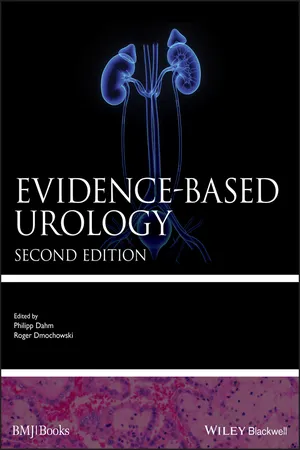
- English
- ePUB (mobile friendly)
- Available on iOS & Android
Evidence-based Urology
About this book
An updated and revised resource to evidence-based urology information and a guide for clinical practice
The revised and updated second edition of Evidence-Based Urology offers the most current information on the suitability of both medical and surgical treatment options for a broad spectrum of urological conditions based on the best evidence available. The text covers each of the main urologic areas in specific sections such as general urology, oncology, female urology, trauma/reconstruction, pediatric urology, etc. All the evidence presented is rated for quality using the respected GRADE framework. Throughout the text, the authors highlight the most patient-important, clinical questions likely to be encountered by urologists in day-to-day practice.
A key title in the "Evidence-Based" series, this revised and expanded edition of Evidence-Based Urology contains new chapters on a variety of topics including: quality improvement, seminoma, nonseminomatous germ cell tumor, penile cancer, medical prophylaxis, vesicoureteral reflux disease, cryptorchidism, prenatal hydronephrosis, and myelodysplasia. This updated resource:
- Offers a guide that centers on 100% evidence approach to medical and surgical approaches
- Provides practical recommendations for the care of individual patients
- Includes nine new chapters on the most recently trending topics
- Contains information for effective patient management regimes that are supported by evidence
- Puts the focus on the most important patient and clinical questions that are commonly encountered in day-to-day practice
Written for urologists of all levels of practice, Evidence-Based Urology offers an invaluable treasure-trove of evidence-based information that is distilled into guidance for clinical practice.
Frequently asked questions
- Essential is ideal for learners and professionals who enjoy exploring a wide range of subjects. Access the Essential Library with 800,000+ trusted titles and best-sellers across business, personal growth, and the humanities. Includes unlimited reading time and Standard Read Aloud voice.
- Complete: Perfect for advanced learners and researchers needing full, unrestricted access. Unlock 1.4M+ books across hundreds of subjects, including academic and specialized titles. The Complete Plan also includes advanced features like Premium Read Aloud and Research Assistant.
Please note we cannot support devices running on iOS 13 and Android 7 or earlier. Learn more about using the app.
Information
PART 1
Evidence‐based methods
CHAPTER 1
Searching for evidence
The shape of clinical literature
BOX 1.1 A hierarchy of resources.
- Summaries, syntheses and guidelines
- 1.1 Point‐of‐care summaries (e.g. DynaMed, UpToDate)
- 1.2 Practice guidelines (e.g. NICE, International Guidelines Clearinghouse)
- 1.3 Evidence‐based textbooks (e.g. Campbell–Walsh Urology and other textbooks available via Clinical Key, Access Medicine, and Books@Ovid)
- Preappraised research
- 2.1 Synopses of systematic reviews (e.g. DARE [Database of Abstracts of Reviews of Effects], ACP Journal Club)
- 2.2 Systematic reviews (e.g. Cochrane Reviews)
- 2.3 Synopses of primary studies (e.g. ACP Journal Club, Evidence‐Based Medicine, McMasterPLUS)
- Primary studies
- 3.1 Filtered (e.g. Clinical Queries in MEDLINE/PubMed)
- 3.2 Unfiltered (e.g. PubMed, EMBASE, BIOSIS, Web of Science)
A case to consider
Table of contents
- Cover
- Table of Contents
- PART 1: Evidence‐based methods
- PART 2: General urology and stone disease
- PART 3: Pediatric urology
- PART 4: Prostate cancer
- PART 5: Kidney and bladder cancer
- PART 6: Testis and penile cancer
- PART 7: Female urology, trauma, and reconstruction
- PART 8: Male LUTS and sexual dysfunction
- Index
- End User License Agreement